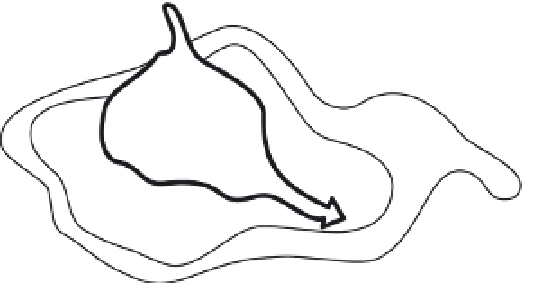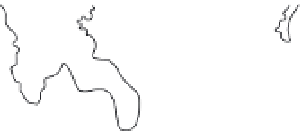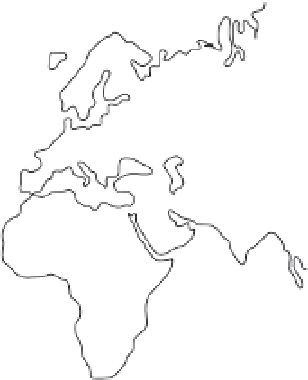Geoscience Reference
In-Depth Information
60
230
60
220
0
20 m
40
65
130
100
80
60
105
110
120
120
60 m
40
20
0
shallow mantle and may be responsible for the
magmatism associated with continental breakup
and
Fig. 14.5
Map of continental flood basalts, selected volcanic
islands, and oceanic plateaus, with ages in millions of years.
The period between 130 and 65 Ma was one of extensive
volcanism and most of this occurred inside geoid highs
(contours) and areas of high elevation. Some of the basalt
provinces have drifted away from their point of origin
(arrows). (See also Fig. 5.5.)
the
formation
of
oceanic
plateaus
some
40--80 Myr after breakup.
Volcanic or island arcs typically occur 100--250
km from convergent plate boundaries and are
of the order of 50--200 km wide. The volca-
noes are generally about 100--200 km above the
earthquake foci of the dipping seismic zone.
Crustal thicknesses at island arcs are generally
20--50 km thick. The upper bound may be the
basalt-eclogite phase change boundary and the
level of crustal delamination. Andesitic volcan-
ism appears to initiate when the slab has reached
a depth of 70 km and changes to basaltic vol-
canism when the slab is no longer present or
when compressional tectonics changes to exten-
sional tectonics. Figure 14.6 shows that island-arc
basalts (hatched) overlap ocean-island and conti-
nental basalts in isotopic characteristics. A simi-
lar mantle source is indicated, and it is probably
shallow.
Back-arc-basin basalts (BABB) are similar to
midocean-ridge basalts but in many respects they
are transitional toward island-arc tholeiites and
ocean-island basalts (Tables 14.4, 14.5 and 14.6).
They are LIL-enriched compared with normal
MORB and generally have LREE enrichment. High
3
He/
4
He ratios have been found in some BABB,
in spite of the fact that they are cut off from
by crystal fractionation may all be involved.
Andesites probably originate in or above the sub-
ducted slab and, therefore, at relatively shallow
depths in the mantle. The thick crust in most
andesitic environments means that shallow-level
crystal fractionation and crustal contamination
are likely. In their incompatible-element and iso-
topic chemistry, andesites are similar to ocean-
island basalts and continental flood basalts. They
differ in their bulk chemistry.
Calc-alkalic andesite production involves mix-
ing of two end-member magmas, a mantle-
derived basaltic magma and a crust-derived fel-
sic magma. The bulk continental crust possesses
compositions similar to calc-alkalic andesites. If
continental crust is made at arcs, the mafic
residue after extraction of felsic melts must
be removed -- delaminated from the initial
basaltic arc crust -- in order to form andesitic
crust. Chemically modified oceanic materials and
delaminated
mafic
lower
crust
materials,
cre-
ate
chemical
and
melting
anomalies
in
the


















































































































